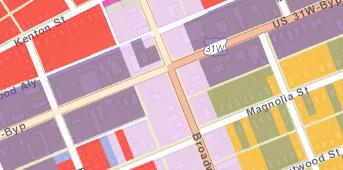
3 minute read
SECTION 6: TEAR OUT SUMMARY Summary for pocket reference or a handout
People’s Guide to Planning in Bowling Green Summary Sheet
The planning entity serving Bowling Green is the City County Planning Commission (CCPC).
Advertisement
https://warrenpc.org/
270-842-1953
f
City County Planning Commission or @BGWCplanning
Comprehensive Planning is planning
for the long-term. It sets the vision, goals, and actions for a 20 to 30 year timeline. Local land use regulations are based on the comprehensive plan vision and goals. Comprehensive plans are guiding policy documents.
Implementation Implementation of the comprehensive plan includes things like development regulations, capital projects, and programming. • Development regulations involve things like zoning and building design guidelines that are guided by the comprehensive plan • Capital improvements involve creating, improving, replacing, or repairing city assets such as land, parks, streets, buildings, utilities, etc. • Programming can be a wide range of things like a neighborhood planning program, a city or county program that offers incentives to developers to provide some number of affordable units in their projects, or volunteer programs.
Zoning organizes uses on the land to promote the general welfare of the planning area. It determines where different types of development can be built. The comprehensive plan informs the Future Land Use Map (FLUM) which is the mapped plan for future development. Zoning says where residential, commercial, industrial uses, and other uses will be located on the land.
Development Review
The city has a process for approving development projects as a way to enforce zoning regulations and therefore enforce the comprehensive plan. Projects that abide by all zoning regulations and do not require any type of zoning change are considered staffapprovable projects. Projects that do include a change in zoning are considered Planning Commission-level projects. Planning Commission Staff are legally limited and often cannot deny a project that meets all appropriate zoning and building regulations which illustrates the importance of the comprehensive planning process.
How to find out about new development projects in your neighborhood:
• Check the City County Planning Commission website and social media • Look for posted signage in your neighborhood regarding rezonings or public hearings for new development. Signs are posted on development sites 14 days prior to public hearings • Call City County Planning Commission and ask
What to do if you have concerns or questions about a development project:
• For staff-approvable projects (projects that meet all zoning regulations that do not require a public hearing), call CCPC to ask questions and voice your concerns. • For Planning Commission level projects (rezonings or other projects that require a public hearing): attend or have proper representation at the planning commission public hearing to get your concerns on record.
When to act:
If you want to participate, you will need to act immediately after you see a notice of a public hearing. For staff-approvable projects, the site development plans are posted after approval on the CCPC website for public viewing. Those approvals are final and there is no public hearing. For rezonings or Planning Commissionlevel projects, the public hearing is the most important time to get your comments and demands on record. Acting as soon as you see a notice about a project will be helpful if you want to organize neighbors and have a large turnout at the public hearing. • projects to adhere to the adopted comprehensive plan and current zoning or future land use map • proper notice to be given for changes to zoning text or map • Types of notices: published, posted, mailed • Timeline: published notices of public hearings are to be up no later than 7 days and no earlier than 21 days prior to the hearing. Most notices are required to be published, posted, or mailed 14 days prior to a public hearing. Mailings go to adjoining property owners, and in some cases, adjoining addresses/ residents. • More information on required notice is in Article 3 of the Zoning Ordinance







